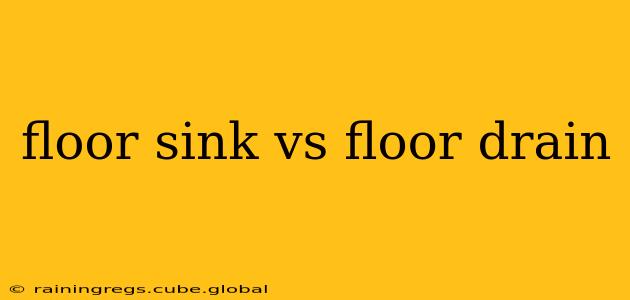Choosing between a floor sink and a floor drain often hinges on the specific needs of your space. While both serve the purpose of draining water from the floor, their designs, functionalities, and applications differ significantly. This comprehensive guide will clarify the key distinctions, helping you make an informed decision for your project.
What is a Floor Sink?
A floor sink, sometimes called a floor drain with a strainer, is a recessed basin integrated into the floor. It's essentially a small, shallow sink with a drain opening located at the bottom. These sinks are typically larger than floor drains and are designed to accommodate larger volumes of water and debris. They often feature a grate or strainer to prevent larger items from clogging the drainpipe. Floor sinks are commonly found in industrial settings, garages, auto repair shops, and commercial kitchens where significant amounts of water and potentially larger debris need to be cleaned up efficiently.
What is a Floor Drain?
A floor drain, in contrast, is a simple drain opening set into the floor, often with a grate or cover to prevent debris from entering. It's designed for smaller water volumes and is typically less robust than a floor sink. These are frequently found in shower rooms, bathrooms, basements, and laundry rooms to efficiently drain away water and prevent standing puddles.
What are the Key Differences Between a Floor Sink and a Floor Drain?
The primary differences lie in their size, capacity, and intended use:
-
Size and Capacity: Floor sinks are significantly larger than floor drains, capable of handling larger volumes of water and debris. Floor drains are smaller, suited for smaller spills and general water drainage.
-
Debris Handling: Floor sinks usually incorporate a strainer or grate, offering better protection against larger debris clogging the drainpipe. Floor drains may also have a grate but are generally less effective at preventing larger particles from entering the drainage system.
-
Intended Use: Floor sinks are ideal for spaces generating significant water and debris, like commercial kitchens or workshops. Floor drains are more suitable for residential settings or areas with moderate water runoff.
-
Appearance: Floor sinks, due to their larger size and basin, have a more prominent visual presence than floor drains, which are more discreet.
-
Installation: Both require professional installation, but floor sinks involve more complex plumbing and require careful consideration of the floor structure.
What are the Pros and Cons of Each?
Floor Sink:
Pros:
- High capacity for water and debris.
- Improved drainage efficiency for large spills.
- Better debris prevention with integrated strainers.
- Suitable for harsh environments and industrial settings.
Cons:
- More expensive to purchase and install.
- More prominent and less aesthetically pleasing in some settings.
- Requires more complex plumbing.
Floor Drain:
Pros:
- Less expensive and simpler to install.
- More discreet and aesthetically pleasing.
- Suitable for residential applications and moderate water runoff.
Cons:
- Lower capacity and may be easily overwhelmed by large spills.
- Less effective at preventing debris from clogging the drain.
Which One Should I Choose?
The best choice depends entirely on your specific needs and the environment:
-
Choose a floor sink if: you need to handle significant volumes of water and debris, such as in a commercial kitchen, workshop, or garage.
-
Choose a floor drain if: you need a simple, cost-effective solution for moderate water drainage in a residential bathroom, laundry room, or basement.
How do I choose the right size?
The size of both floor sinks and drains should be determined by the expected water volume and the drainage capacity of your plumbing system. Consult with a plumber to ensure proper sizing to prevent future issues.
What about maintenance?
Both floor sinks and drains require regular maintenance to prevent clogging. Regular cleaning of the grate or strainer and periodic flushing of the drain lines are crucial to maintain optimal drainage.
By understanding these key distinctions, you can confidently select the ideal drainage solution for your project, ensuring efficient and reliable water management. Remember to consult with a qualified plumber for professional installation and advice tailored to your specific situation.
